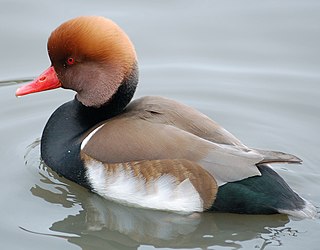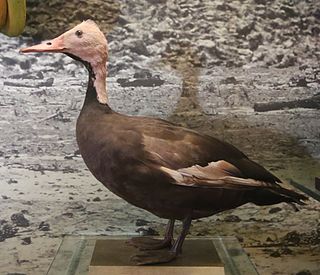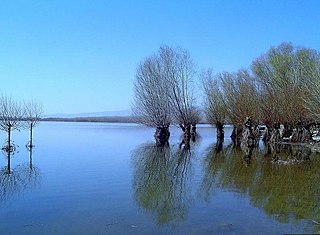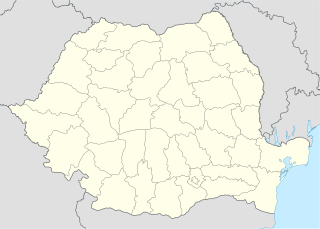
The diving ducks, commonly called pochards or scaups, are a category of duck which feed by diving beneath the surface of the water. They are part of Anatidae, the diverse and very large family that includes ducks, geese, and swans.

The redhead is a medium-sized diving duck. The scientific name is derived from Greek aithuia, an unidentified seabird mentioned by authors including Hesychius and Aristotle, and Latin americana, of America. The redhead is 37 cm (15 in) long with an 84 cm (33 in) wingspan. Redhead weight ranges from 2.0 to 2.5 lbs, with males weighing an average of 2.4 lbs and females weighing an average of 2.1 lbs. It belongs to the genus Aythya, together with 11 other described species. The redhead and the common pochard form a sister group which together is sister to the canvasback.

The common pochard is a medium-sized diving duck. The scientific name is derived from Greek aithuia an unidentified seabird mentioned by authors including Hesychius and Aristotle, and Latin ferina, "wild game", from ferus, "wild".
Scaup is the common name for three species of diving duck:

The hardhead, also known as the white eyed duck, is the only true diving duck found in Australia. The common name "hardhead" has nothing to do with the density of the bird's skull, instead referring to the difficulty encountered by early taxidermists in processing the head. Hardheads are found in wetter, coastal regions of Australia, particularly in the south-east, but are known to disperse as far afield as New Guinea, New Zealand, and the Pacific Islands.

The ferruginous duck, also ferruginous pochard, common white-eye or white-eyed pochard is a medium-sized diving duck from Eurosiberia. The scientific name is derived from Greek aithuia an unidentified seabird mentioned by authors including Hesychius and Aristotle, and nyrok, the Russian name for a duck.

The red-crested pochard is a large diving duck. The scientific name is derived from Greek Netta "duck", and Latin rufina, "golden-red". Its breeding habitat is lowland marshes and lakes in southern Europe and it extends from the steppe and semi-desert areas on the Black Sea to Central Asia and Mongolia, wintering in the Indian Subcontinent and Africa. It is somewhat migratory, and northern birds winter further south into north Africa.

Aythya is a genus of diving ducks. It has twelve described species. The name Aythya comes from the Ancient Greek word αυθυια, which may have referred to a sea-dwelling duck or an auklet.

The rosy-billed pochard, alternatively named rosybill or rosybill pochard, is a member of family Anatidae. Though classified as a diving duck, this pochard feeds more like a dabbling duck feeding on seeds roots, sedges, aquatic plants and other grasses. Netta is Ancient Greek for "duck" and peposaca is a transcription of the Guaraní name of this species which means "showy wings", referring to the broad white stripe that is only visible with stretched out wings. Male characteristic features include a bright red bill with a rounded knob at the base.

Netta is a genus of diving ducks. The name is derived from Greek Netta "duck". Unlike other diving ducks, the Netta species are reluctant to dive, and feed more like dabbling ducks.

The pink-headed duck is a large diving duck that was once found in parts of the Gangetic plains of India, Bangladesh and in the riverine swamps of Myanmar but feared extinct since the 1950s. Numerous searches have failed to provide any proof of continued existence. It has been suggested that it may exist in the inaccessible swamp regions of northern Myanmar and some sight reports from that region have led to its status being declared as "Critically Endangered" rather than extinct. The genus placement has been disputed and while some have suggested that it is close to the red-crested pochard, others have placed it in a separate genus of its own. It is unique in the pink colouration of the head combined with a dark body. A prominent wing patch and the long slender neck are features shared with the common Indian spot-billed duck. The eggs have also been held as particularly peculiar in being nearly spherical.

The Madagascar pochard or Madagascan pochard is an extremely rare diving duck of the genus Aythya. Thought to be extinct in the late 1990s, specimens of the species were rediscovered at Lake Matsaborimena near Bemanevika in Madagascar in 2006. By 2017, a captive breeding program had produced a population of around 90 individuals. The birds were reintroduced to the wild in December 2018.

Baer's pochard is a diving duck found in eastern Asia. It breeds in southeast Russia and northeast China, migrating in winter to southern China, Vietnam, Japan, and India. The name commemorates the Estonian naturalist Karl Ernst von Baer.

The southern pochard is a species of duck, and a member of the genus Netta. There are two subspecies, the South American (southern) pochard N. e. erythrophthalma and the African (southern) pochard N. e. brunnea.

The Euxine–Colchic deciduous forests is a temperate broadleaf and mixed forests ecoregion located along the southern shore of the Black Sea. The ecoregion extends along the thin coastal strip from the southeastern corner of Bulgaria in the west, across the northern coast of Turkey, to Georgia in the east, where it wraps around the eastern end of the Black Sea.

Lake Işıklı is a freshwater lake in Turkey's inner Aegean Region extending on Çivril Plain between the provinces of Denizli and Afyonkarahisar. The lake is bordered by the boundaries of several districts, namely, clockwise Çivril, the principal urban center of the region, and Kızılören, Dinar and Evciler. A township on the lake shore and that is part of Çivril district carries the same name as the lake (Işıklı).
A. innotata may refer to:

The Cefa Natural Park is a protected area situated in Romania, on the administrative territory of Bihor County.

Hail Haor Wildlife Sanctuary is a major wildlife sanctuary in Bangladesh. It is one of the most important wetlands in the Sylhet Basin for the resident and migratory waterfowls. It is also important watersource for the inhabitants living around when all other sources dry up during summer. The sanctuary is located in Moulvibazar District, in the northeast region of the country.
















